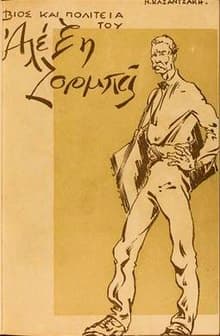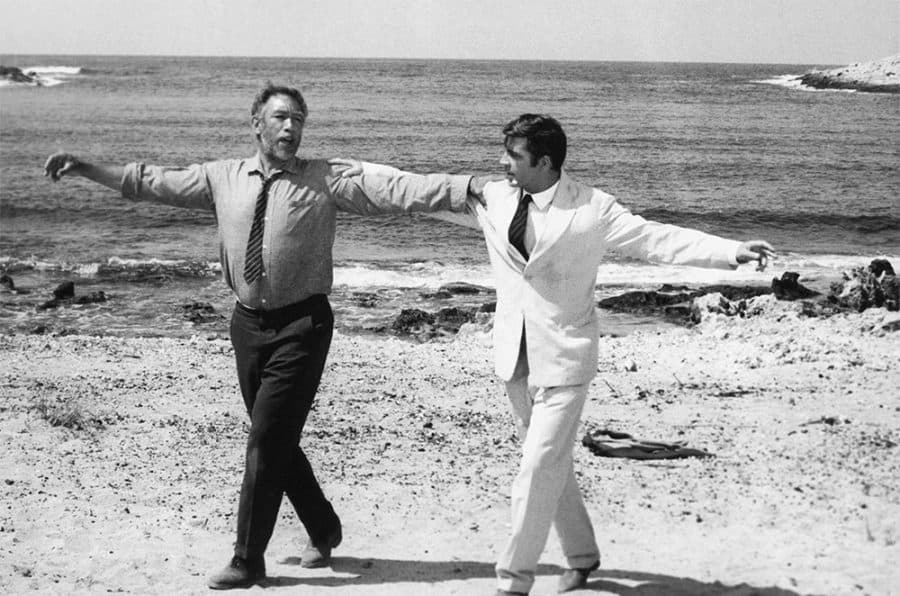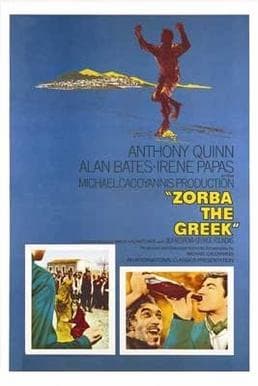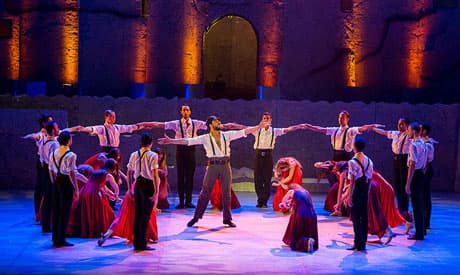The Cretan novelist Nikos Kazatzakis brought us the expansive personality of Zorba the Greek in his 1946 novel Βίος και Πολιτεία του Αλέξη Ζορμπά (Life and Times of Alexis Zorbas). The education of a nameless well-meaning Greek intellectual, who has been attracted by socialist ideals, by the rough and ready Zorba is the opening for long discussions on life, reality, the human condition, religion, and so on. In post-war Europe, where everyone’s ideals had been set on end by the unbelievable changes over the past four years, this kind of discussion was everywhere. The intellectual’s foray in Crete is ultimately unsuccessful and he departs, never to see Zorba again, but to never forget his contributions to his life.

First Edition cover
The book found a worldwide audience – some through the book, and others through the 1964 film, starring Anthony Quinn as Zorba and Alan Bates as the narrator, now transformed from a Greek intellectual to an English writer (suffering writer’s block) named Basil who has come to a small Greek island for his inheritance of a small coal mine. The large-than-life Zorba is Basil’s key to actually finding his emotions and living. Music for the film was written by Mikis Theodorakis (1925–2021). The high point of the film was the final dance on the beach, where Zorba teaches Basil to dance, and thereby liberates his buttoned-down (and somewhat unsuccessful) boss to be able to complete his writing, ostensibly a work on the life of Buddha but really a life of Zorba.

Zorba and Walter dance on the beach
Mikis Theodorakis: Zorbas o Ellinas (Zorba the Greek): Act II Scene 23: Zorba’s Dance: Greetings, Creta, Mother Earth (Sophia Michaelidi, mezzo-soprano; Kostas Papadopoulos and Lakis Karnezis, bouzouki; Hungarian Radio Chorus; Hungarian State Orchestra; Mikis Theodorakis and Lukas Karytinos, conds.)

1964 Film poster
Following the motion picture, we had the 1968 Broadway musical, now simply known as Zorba. Now the young protagonist is an American of Greek background named Nikos. The story has been slimmed down immeasurably from Kazantzakis’ philosophical original but successful nevertheless. The music and lyrics were by John Kander and Fred Ebb. The musical had a revival in 1983, starring Anthony Quinn and Lila Kedrova from the film. The musical doesn’t close with his transformative dance but more of a statement of Zorba’s life: live every day as if it were your last, in the song ‘I am Free’.
John Kander: Zorba – Act II: I Am Free (Zorba) – Life Is (reprise) (Leader, Company) (Anthony Quinn, Zorba; Debbie Shapiro, The Woman; Zorba Ensemble; Randolph Mauldin, cond.)
And now we have Zorba the ballet, created in 1987 and given its premiere at the Arena di Verona. As a ballet, the words have to get set aside and the dancing comes to the fore.

Cairo Opera Ballet and Zorba, Hany Hassan in the title role (photo by Bassam Al Zoghby)
The music for this production goes back to Mikis Theodorakis’ music for the film and again closes with Zorba’s dance. Instead of a dance by the two men on the beach, as the movie had, this has the whole company on stage and Zorba no longer has to teach the narrator, now named John, how to dance.
Mikis Theodorakis: Zorbas o Ellinas (Zorba the Greek) – Act II: Zorba’s Dance (Sophia Michaelidi, mezzo-soprano; Kostas Papadopoulos, bouzouki; Lakis Karnezis, bouzouki; Hungarian Radio Chorus; Hungarian State Orchestra; Mikis Theodorakis cond.; Lukas Karytinos, cond.)
It was the inspiration of Theorodarkis’ music for the final dance, which was newly composed and choreographed and is known as the ‘sirtaki’, that drove the popularity of the idea of Zorba. It’s a cruel story with 2 women’s deaths directly attributed to the actions of our two heroes, but it’s the final dance that saved the work.
The music, composed by Theodorakis, was derived from the music of urban lower and working-class Greece called ‘rebetiko’. It was the folk song of the cities (in 2017 UNESCO placed it on the list of Intangible Cultural Heritage of Humanity). The music itself and its lyrics were adapted from a traditional composition from the city of Chania in Crete by the Cretan musician Giorgio Koutsourelis, chosen for its energetic rhythm and resemblance to the rebetika. The song was released as a single in 1965, and was picked up by performers all over the world, and both Theordorakis’ and others’ versions hit the top of the pop charts in Austria, Belgium and hit No. 5 in Dutch Top 40 and charted in the US as well. In Greece, from 1967 to 1974, all of Theodorakis’ music was banned by the ruling junta.
The ‘sirtaki’ dance in the movie was a combination of the Cretan circle dance called the ‘syros’, with the foot drag changed to a hop, and a slower-style ‘hasapiko’ dance, and a faster ‘hasaposerviko’; the latter two dances came to Greece from Constantinople. ‘Hasapiko’ means The butcher’s dance and was originally danced with a sword.
To see a novel transformed to a movie to a musical to a ballet is unusual; to have it conveyed by its music is noteworthy!
For more of the best in classical music, sign up to our E-Newsletter

